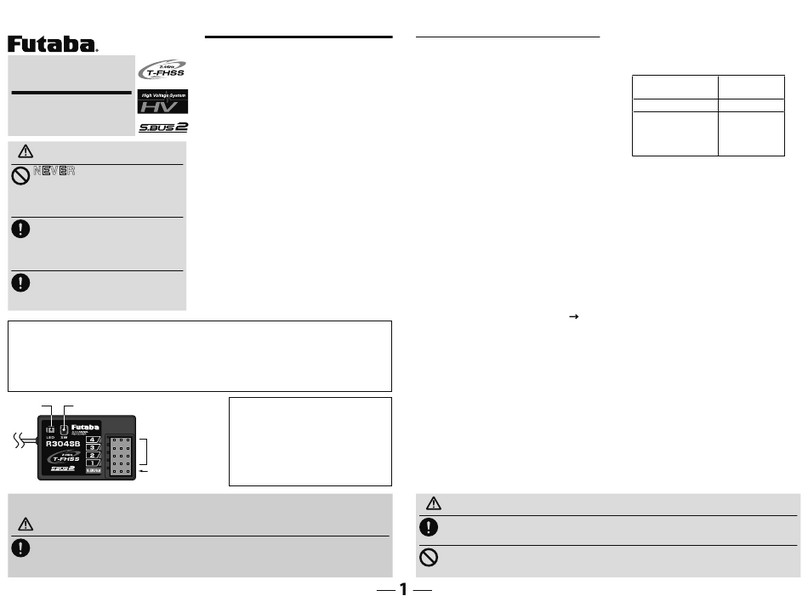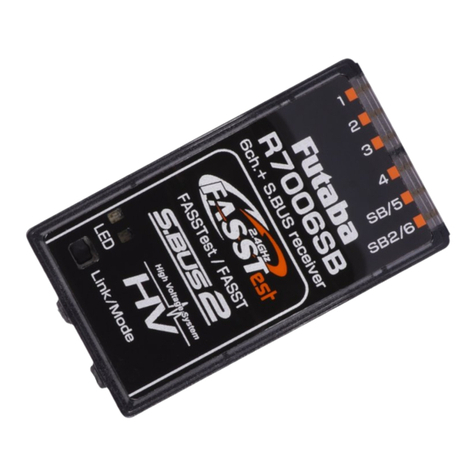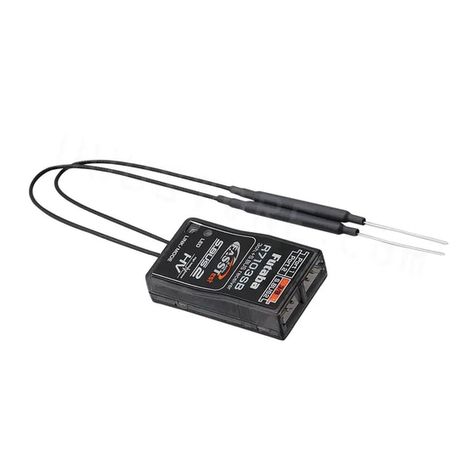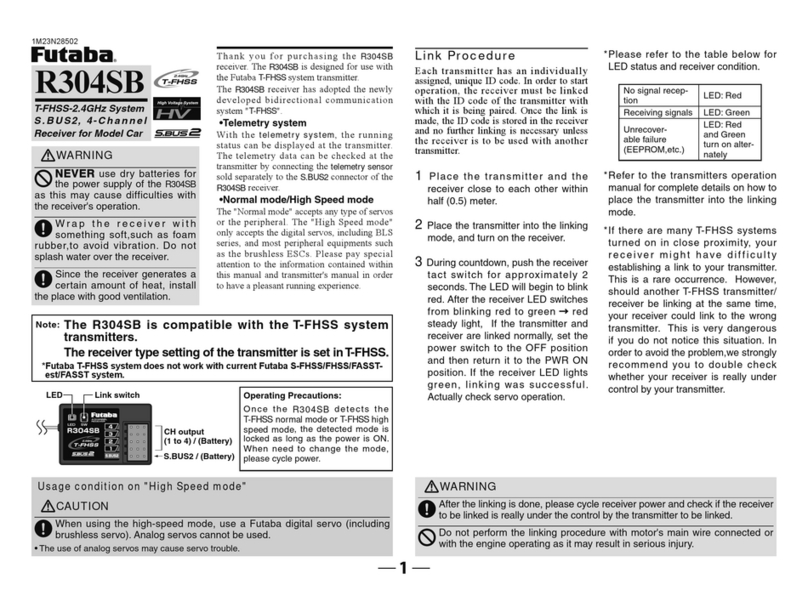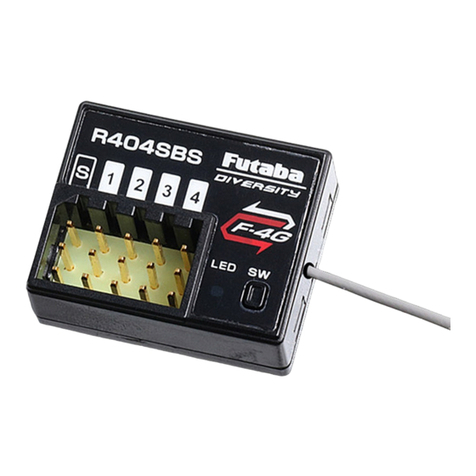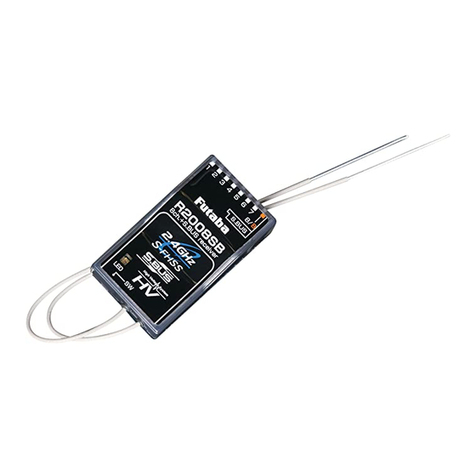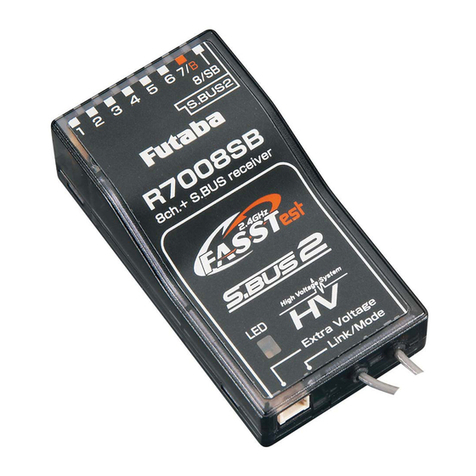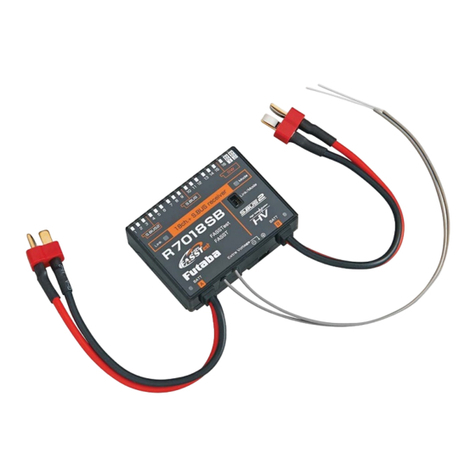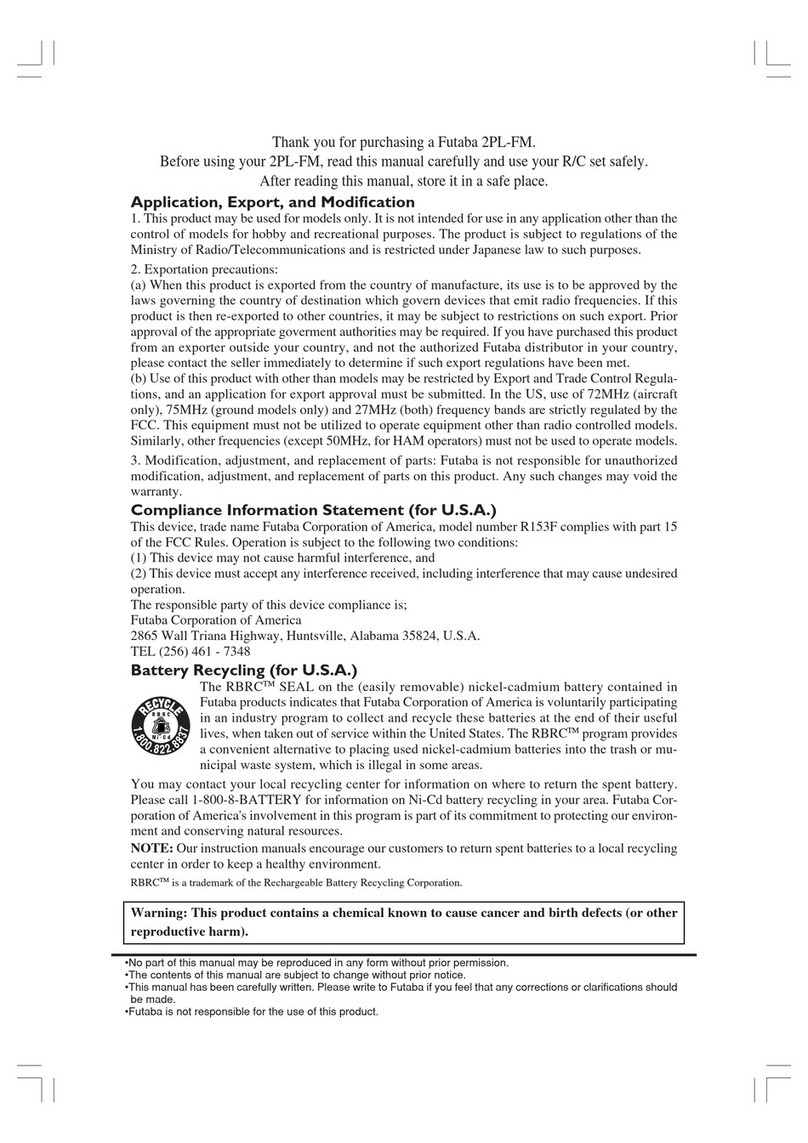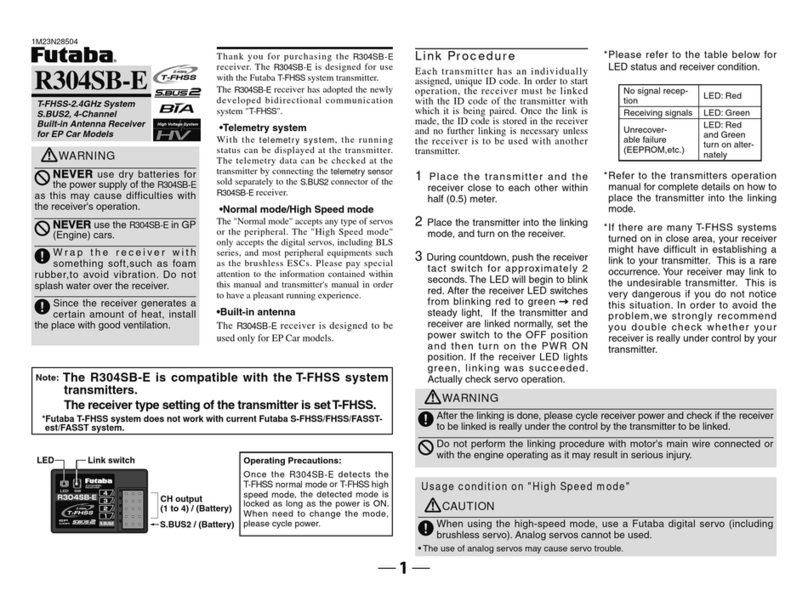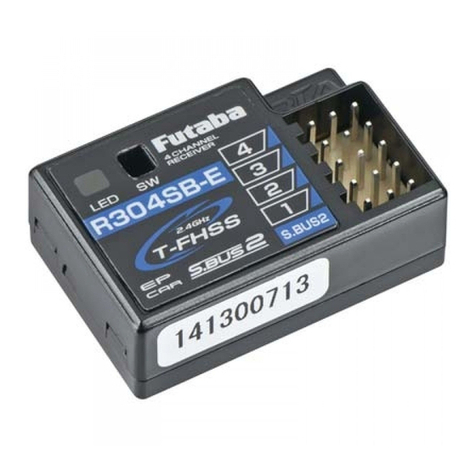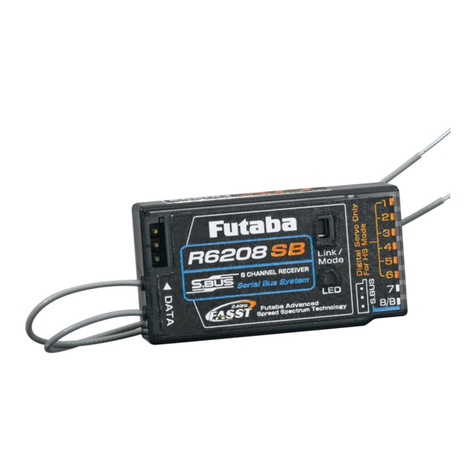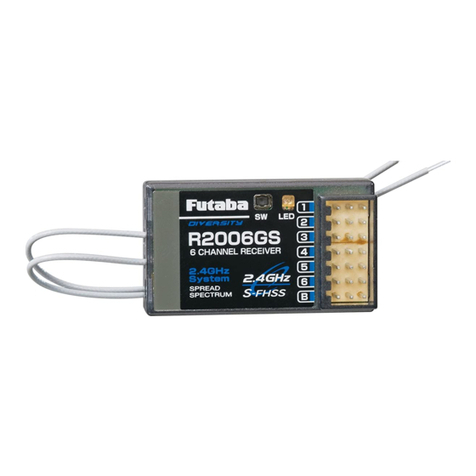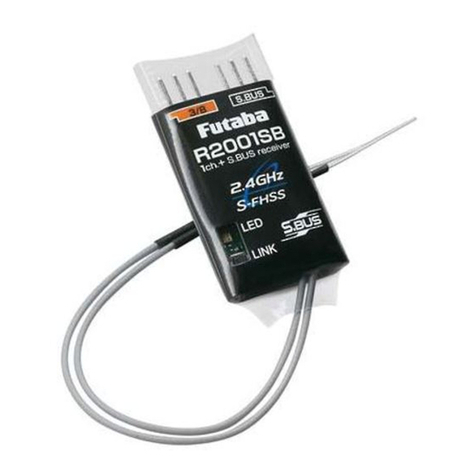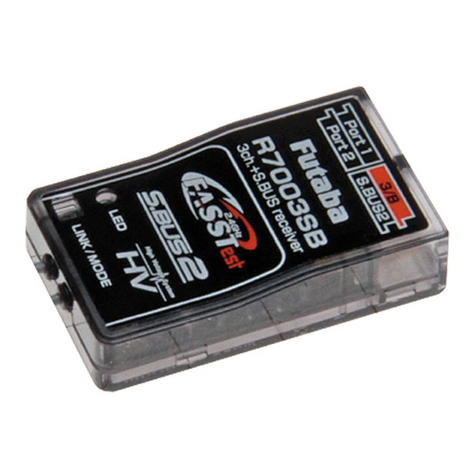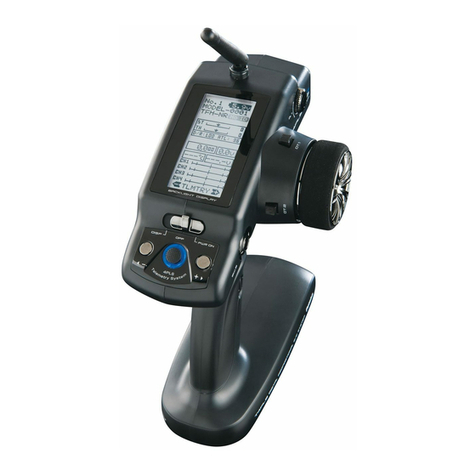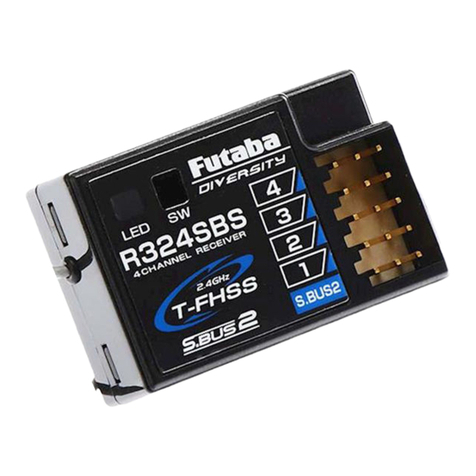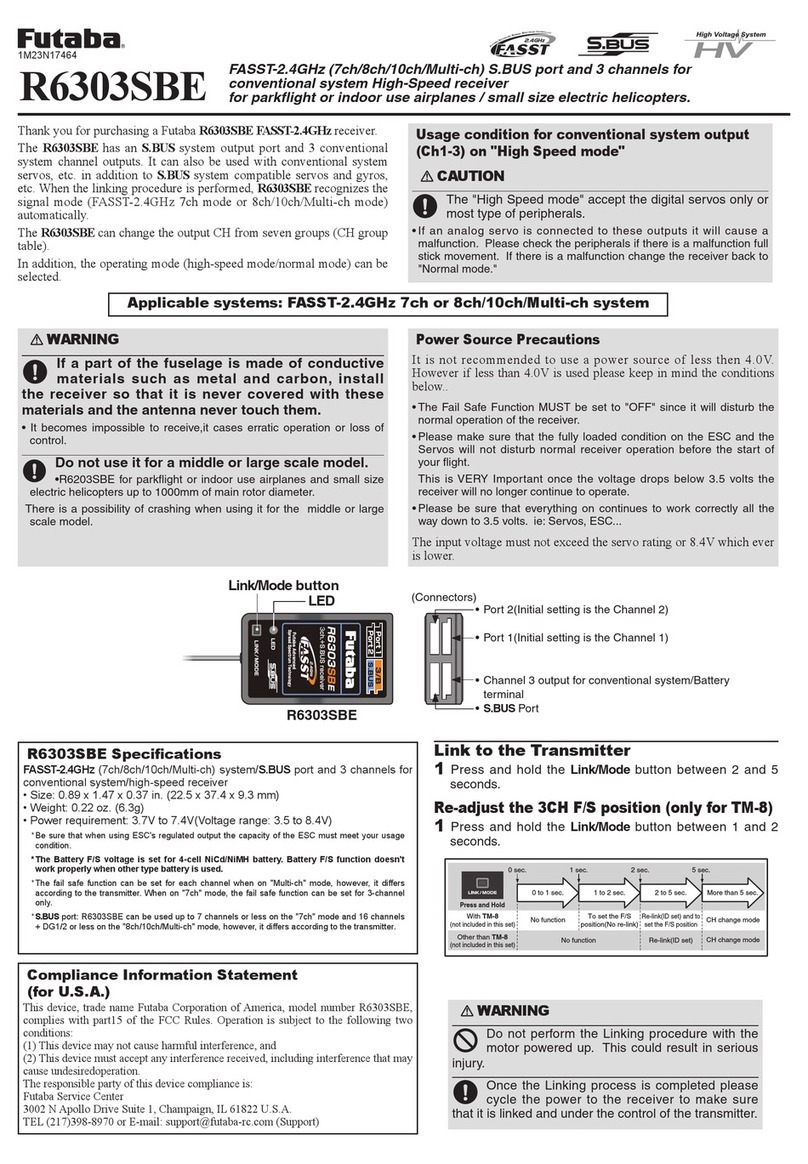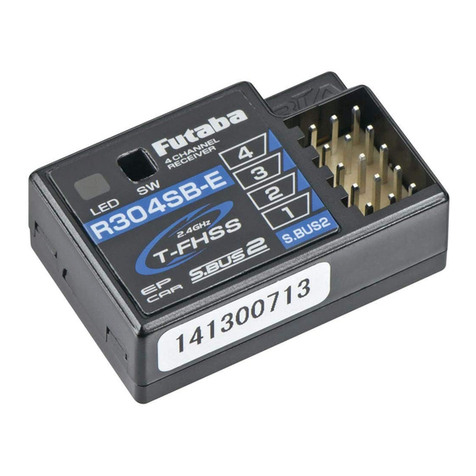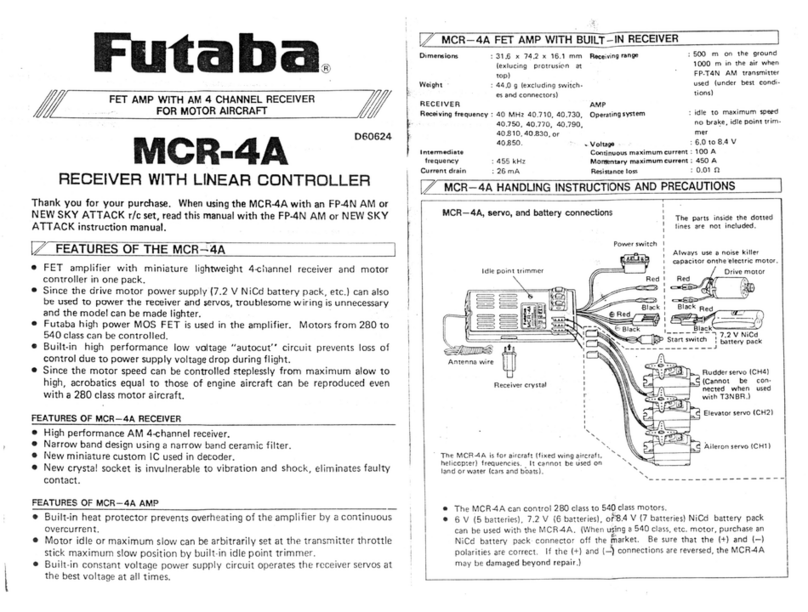Attachment of the Module
nCAUTION
jBe sure to turn off the power of the transmitter before
you install or replace the module.
1Prior to attaching the module to the transmitter, it is
important that the transmitter's software is updated
accordingly. To obtain the software update, please
follow the instructions that accompanied your respective
transmitter. Update the transmitter as per the instruction
manual. Additionally, this update will also include written
instructions on the operation and use of the TM-14
module and R6014FS receiver. As such, we strongly
suggest that you read them carefully before proceeding.
2While it is unlikely that the existing transmitter
antenna will interfere with the radio frequency
transmission of the TM-14, we suggest not installing it in
the transmitter as a precautionary measure.
3Next, with the transmitter's power off, remove the
existing transmitter module and install the TM-14
module with care so that the connector pins of the
transmitter won't be damaged.
4Turn on the transmitter's
power and switch the RF
band to 2.4GHz. To do so,
please follow the instructions
that were included in the
software update.
Antenna of TM-14
1As with all radio frequency transmissions, the
strongest area of signal transmission is from the
sides of the TM-14 transmitter module's antenna. As
such, the antenna should not be pointed directly at the
model. If your flying style creates this situation, easily
move the antenna to correct this situation.
2Please do not grasp the transmitter's antenna
during flight. Doing so may degrade the quality of
the RF transmission to the model.
Easy Link
Each TM-14 transmitter module has an individually assigned
unique ID code. In order to start operation, the receiver must be
linked to the respective TM-14's ID code. Once the linking is
done, the ID code is stored in the receiver and the re-linking is
not necessary unless the receiver is to be used with a different
TM-14 module.
Additionally, it is important to note that this TM-14 and
R6014FS receiver set has already been linked by the factory.
Should you wish to re-link them, or if you have purchased a
separate receiver and would like to link it to this TM-14, please
adhere to the following procedure.
1After the TM-14 module has been installed into
the transmitter, using the aforementioned steps,
turn on the transmitter and activate the RF transmission
according to the transmitter's instruction manual. The
LED, located on the rear of the TM-14 transmitter module,
should begin to blink momentarily before turning to a solid
green light. If not, power down the transmitter and turn it
on once again.
2With the transmitter on, and the green LED
illuminated, turn on the receiver.
3With the receiver on, the LED on the receiver start
green blinking. This means the receiver is detecting
the TM14's RF signal but the ID code is not linked yet.
4Press and hold the Easy Link button, located on the
top of the receiver, for approximately two seconds
and release it. Then the receiver starts linking procedure.
When the linking process has been completed, the LED
on the receiver will change to a solid green and the linking
is established.
TM-14 LED indication
* When the transmitter is powered up, the LEDs on the rear of the
module will begin to glow or blink accordingly. The chart below pro-
vides you with an easy reference as to the meaning of the LEDs.
LED indication
Green Red Status
Solid Solid Initializing
Blink Off RF is off
Alternate Blink Check nearby RF condition
Solid Off RF power on
Solid Blink RF power on (Power reduced to perform the
range check function))
Receiver Installation and Channel
Assignment
You will note that the R6014FS differs in appearance from
the standard Futaba receiver. The R6014FS incorporates two
separate antennas into its design which enables it to receive the
radio frequency transmission at two different locations. Futaba's
dual antenna diversity, or DAD, then seamlessly selects the best
signal reception between these antennas to ensure that there is
no loss of signal.
Antenna
*Must be kept as straight as possible.
Coaxial cable
R6014FS Receiver
Additionally, it is imperative to note that the servo grouping
in the FASST system differs from that of the standard G3
PCM receivers. Futaba's FASST system data is transmitted in
packets of four channels. Therefore, when utilizing the FASST
system, channels 1-4, 5-8 and 9-12 are grouped together.
Please refer to the instructions that were included with the
software download for information on how to optimize your
set-up for peak performance and satisfaction.
To obtain the best results from the R6014FS receiver, please
refer to the following instructions and precautions:
1Install the receiver in the aircraft using the same
methodology as you would a standard receiver. That
is, make sure that you wrap the receiver in foam rubber
or other such material to make it less susceptible to
vibration, etc.
2Ensure that the two receiver antennas are kept as
straight as possible. This will allow you to obtain the
maximum effective range from your model.
3If possible, please make sure that the two antennas
are placed at 90 degrees to each other. Please note:
This is not a critical figure, however, the most important
thing is to keep the antennas away from each other as
much as possible.
4If your model includes metal conductive items which
may impact the receiver's ability to clearly receive
the radio frequency signal, we suggest mounting the
receiver so that the receiver antennas exit both sides of
the model. This will allow the best radio frequency signal
condition at any flying attitude.
5Ensure that the antennas are at least 1/2" away from
any conductive materials such as metal and carbon.
Please note: this is not applicable to the coaxial portion
of the antenna. It is important, however, to not bend the
coax, or antenna in a tight radius.
6If the fuselage is made of conductive materials such
as metal and carbon, the antennas part MUST be
positioned so that they exit the fuselage. Additionally, do
not attach the antenna itself to this fuselage.
* For example, there are many types of gliders which use carbon
fuselage. When installing the receiver into such models, it is impera-
tive that the antenna precautions are adhered to strictly.
nWARNING
jBe very careful when handling the receiver antennas.
Repeated bending and flexing of the antennas or ex-
cessive force could weaken or compromise the internal an-
tenna connections.
jKeep the antennas away from the motor, ESC, and
other noise sources as much as possible.
Antenna Antenna
• The main purpose of the photo demonstrates how the antenna
should be placed. For actual installation the receiver must be
ZUDSSHGZLWKDVSRQJH RUSODFHGZLWKÀRDWLQJ PDWHULDOWRSURWHFWLW
from vibration.
• The receiver contains delicate electronic parts and should be pro-
tected from vibration, shock and temperature extremes.
• The receiver is not impervious to damage from moisture. If moisture
should enter the receiver, intermittent operation or failure may result.
To prevent this from occurring, we suggest wrapping the receiver in
a plastic bag or similar protective covering. This will also protect the
receiver from any fuel or exhaust residue which can work its way
into the fuselage.
R6014FS LED indication
Green Red Status
Off Solid No signal received
Solid Off Signal received, normal operation
Blink Off Reciever is receiving signals but the ID is unmatched
Alternate blink Unrecoverable error (EEPROM, etc.)
F/S (Fail Safe) setting
The TM-14 allows the modeler to adjust the Fail Safe settings
via the transmitter. There are two different operational RF
modes offered by the TM-14: "MULTI-CH" and "7-CH mode".
The available Fail Safe settings vary depending upon which
receiver model and RF mode are being utilized.
7-CH Mode: When using the "7-CH mode", Fail Safe is only
available for channel three (throttle).
MULTI-CH Mode: If you are utilizing the "MULTI-CH"
mode, as is the case with the R6014FS, Fail Safe settings and
operation are identical to that of the fail safe when using the
PCM- G3 receivers.
The F/S is suggested for use as it offers a safety factor when
controlling your models. It is also possible to cancel the F/S
operation if you do not wish to use it.
Range Check the Radio
It is extremely important to range check your models prior to
HDFKÀ\LQJVHVVLRQ7KLVHQDEOHV\RXWRHQVXUHWKDWHYHU\WKLQJ
is functioning as it should and to obtain maximum enjoyment
from your time flying. The TM-14 transmitter module
incorporates a system that reduces its power output and allows
you to perform such a range check.
1Turn on the transmitter and activate the 'RANGE
CHECK' mode through the transmitter's System
menu. Please note: if the RF is activated, the 'RANGE
CHECK' mode will not be available to utilize. As such, do
NOT activate the RF when the transmitter is turned on.
2After the radio frequency has been activated as
indicated by a solid green LED and a blink red LED,
on the TM-14. As indicated by the blinking red LED, the
radio frequency power has been reduced to allow for the
range check.
3Walk away from the model while simultaneously
operating the controls. Have an assistant stand
by the model to confirm that all controls are completely
and correctly operational. You should be able to walk
approximately 30-50 paces from the model without losing
control.
4If everything operates correctly, return to the model.
Set the transmitter in a safe, yet accessible, location
so it will be within reach after starting the engine or motor.
Be certain the throttle stick is in the low throttle position,
then start the engine or motor. Perform another range
check with your assistant holding the aircraft with the
engine running at various speeds. If the servos jitter or
move inadvertently, there may be a problem. We would
strongly suggest you do not fly until the source of the
difficulty has been determined. Look for loose servo
connections or binding pushrods. Also, be certain that the
battery has been fully charged.
Installing the TM-14 Module and R6014FS Receiver
- 2 - - 3 -
